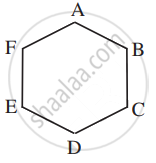Advertisements
Advertisements
Question
Three of the six vertices of a regular hexagon are chosen at random. What is the probability that the triangle with these vertices is equilateral?
Options
`3/10`
`3/20`
`1/20`
`1/10`
Solution
`1/10`
Explanation:
ABCDEF is a regular hexagon.
Total number of triangles 6C3 = 20. ....(Since no three points are collinear).
Of these only ∆ACE; ∆BDF are equilateral triangles.
Therefore, required probability = `2/20 = 1/10`.
APPEARS IN
RELATED QUESTIONS
Describe the sample space for the indicated experiment: A coin is tossed four times.
Describe the sample space for the indicated experiment: A coin is tossed and then a die is rolled only in case a head is shown on the coin.
An experiment consists of tossing a coin and then throwing it second time if a head occurs. If a tail occurs on the first toss, then a die is rolled once. Find the sample space.
If a coin is tossed two times, describe the sample space associated to this experiment.
If a coin is tossed three times (or three coins are tossed together), then describe the sample space for this experiment.
An experiment consists of boy-girl composition of families with 2 children.
What is the sample space if we are interested in knowing whether it is a boy or girl in the order of their births?
A die is thrown repeatedly until a six comes up. What is the sample space for this experiment.
A coin is tossed. Find the total number of elementary events and also the total number events associated with the random experiment.
A card is drawn at random from a pack of 52 cards. Find the probability that the card drawn is not a black card.
In shuffling a pack of 52 playing cards, four are accidently dropped; find the chance that the missing cards should be one from each suit.
A bag contains 7 white, 5 black and 4 red balls. If two balls are drawn at random, find the probability that both the balls are white
A bag contains 6 red, 4 white and 8 blue balls. If three balls are drawn at random, find the probability that one is red
The letters of the word 'FORTUNATES' are arranged at random in a row. What is the chance that the two 'T' come together.
Find the probability that in a random arrangement of the letters of the word 'UNIVERSITY', the two I's do not come together.
20 cards are numbered from 1 to 20. One card is drawn at random. What is the probability that the number on the cards is divisible by 5?
A class consists of 10 boys and 8 girls. Three students are selected at random. What is the probability that the selected group has all boys?
A bag contains tickets numbered from 1 to 20. Two tickets are drawn. Find the probability that both the tickets have prime numbers on them
An urn contains 7 white, 5 black and 3 red balls. Two balls are drawn at random. Find the probability that one ball is red and the other is black
In a large metropolitan area, the probabilities are 0.87, 0.36, 0.30 that a family (randomly chosen for a sample survey) owns a colour television set, a black and white television set, or both kinds of sets. What is the probability that a family owns either any one or both kinds of sets?
Three dice are thrown simultaneously. What is the probability of getting 15 as the sum?
If the letters of the word 'MISSISSIPPI' are written down at random in a row, what is the probability that four S's come together.
If E and E2 are independent evens, write the value of P \[\left( ( E_1 \cup E_2 ) \cap (E \cap E_2 ) \right)\]
If A and B are two independent events such that \[P (A \cap B) = \frac{1}{6}\text{ and } P (A \cap B) = \frac{1}{3},\] then write the values of P (A) and P (B).
One card is drawn from a pack of 52 cards. The probability that it is the card of a king or spade is
The probability of getting a total of 10 in a single throw of two dices is
An ordinary deck of cards contains 52 cards divided into four suits. The red suits are diamonds and hearts and black suits are clubs and spades. The cards J, Q, and K are called face cards. Suppose we pick one card from the deck at random. What is the sample space of the experiment?
A typical PIN (personal identification number) is a sequence of any four symbols chosen from the 26 letters in the alphabet and the ten digits. If all PINs are equally likely, what is the probability that a randomly chosen PIN contains a repeated symbol?
Two boxes are containing 20 balls each and each ball is either black or white. The total number of black ball in the two boxes is different from the total number of white balls. One ball is drawn at random from each box and the probability that both are white is 0.21 and the probability that both are black is k, then `(100"k")/13` is equal to ______.
